
Cottesloe is a western suburb of Perth, Western Australia, within the Town of Cottesloe. Cottesloe was named for Thomas Fremantle, 1st Baron Cottesloe, a prominent Tory politician and the brother of Admiral Sir Charles Fremantle for whom the city of Fremantle was named. The nearby suburb of Swanbourne was named for the Fremantle family seat, Swanbourne House, in Swanbourne, Buckinghamshire.

Thomas George Anstruther Molloy was an Australian politician. He was a member of the Western Australian Legislative Assembly (MLA) for the electorate of Perth from 1892 until 1894, and thereafter became a perennial candidate, unsuccessfully standing for parliament 14 times. He also served two terms as the Mayor of Perth, from 1908 to 1909 and from 1911 to 1912. Molloy made a significant contribution to the cultural life of Perth, building numerous hotels and the first two theatres in the city, most notably His Majesty's Theatre, which is still open today.
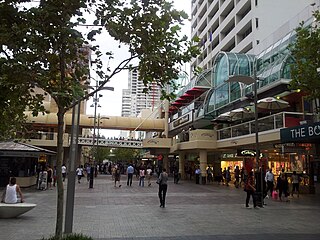
Murray Street is one of four main east-west streets within the Perth central business district (CBD).

Barrack Street is one of two major cross-streets in the central business district of Perth, Western Australia. Together with St Georges Terrace, Wellington Street and William Street it defines the boundary of the main shopping precinct of the central city.

Hay Street is a major road through the central business district of Perth, Western Australia and adjacent suburbs. The street was named after Robert William Hay, the Permanent Under Secretary for Colonies. Sections of the road were called Howick Street and Twiss Street until 1897. One block in the central business section is now a pedestrian mall with extremely limited vehicular traffic, so that it is necessary to make a significant detour in order to drive the entire length of Hay Street.
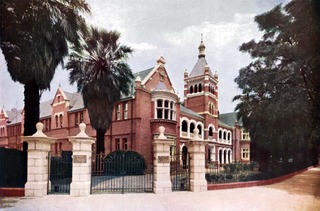
Christian Brothers College (CBC), informally known as CBC Perth or The Terrace was an Independent school for boys situated on St Georges Terrace in the centre of Perth, Western Australia. The college opened in January 1894, and the college was a founding member of the Public Schools Association in 1905. The college was the second high school (1894) and the second boarding school (1896) in Western Australia. In 1938 boarders and some day students at CBC moved to the new Aquinas College campus at Salter Point. Brother C.P. Foley, who was the headmaster of CBC Perth and who at the same was the first headmaster of Aquinas took with him the Christian Brothers College crest and colours, honour boards, and Public Schools Association membership. Brother Foley insisted the heritage of CBC Perth from 1894–1937 belonged to Aquinas. To further enhance Aquinas as the premier the Christian Brothers College, the main building at Aquinas was designed in the Federation Arts and Crafts architecture of CBC Perth. Meanwhile, although most of the day students remained at CBC Perth, numbers were depleted and the college immediately accepted an overflow of students from St Patrick's Boys School on Wellington Street. CBC Perth continued as a day school from 1938–1961. In 1962, the students and staff of CBC Perth moved to a new site on the East Perth foreshore and the college was renamed Trinity College.

Claude Albo de Bernales was a Western Australian mining entrepreneur whose business activities and marketing did much to stimulate investment in Western Australia during the early years of the twentieth century. During the 1930s gold production in the State increased from £1,600,000 to £11,800,000 and employment in the industry quadrupled due in considerable part to de Bernales' marketing of the goldfields to overseas investors.
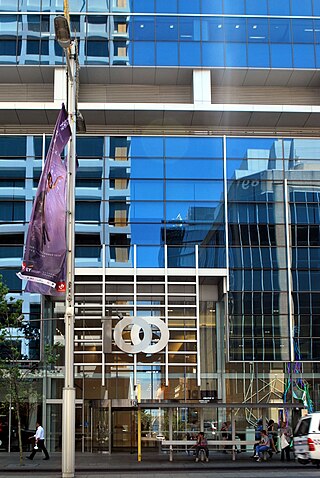
100 St Georges Terrace is a 24-storey skyscraper located at 100 St Georges Terrace in Perth, Western Australia.
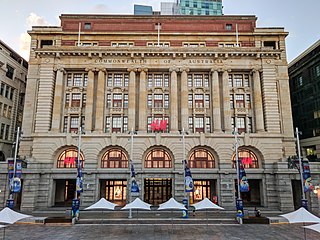
The General Post Office is a heritage landmark building in Perth, Western Australia. Located on the western side of Forrest Place in the city's central business district, its imposing stone facade is in the Beaux-Arts style. The building was completed in 1923 after almost a decade of construction, which was protracted by World War I and the resulting shortages of construction materials. At the time of its opening, it was the largest building in Perth.

The Gledden Building is an Art Deco office building in Perth, Western Australia. The building was constructed on land that had been bequested to the University of Western Australia by surveyor Robert Gledden.
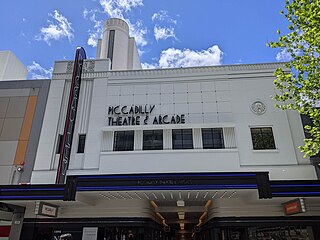
The Piccadilly Cinema Centre and Piccadilly Arcade are located at 700-704 Hay Street, Perth, Western Australia. It is an art deco style cinema and shopping arcade, designed by architect William T. Leighton for mining entrepreneur Claude de Bernales. The theatre and arcade opened in 1938, with the arcade connecting Hay Street through to Murray Street.

The former Plaza Theatre is located at 650–658 Hay Street, Perth, Western Australia. It was the first purpose-designed Art Deco cinema in Perth. The Plaza Theatre opened in 1937 and was built for Hoyts Theatres Ltd.

Sir Charles McNess was an ironmonger and philanthropist.

Lawson Apartments are located at 2–4 Sherwood Court near the corner with The Esplanade, in Perth, Western Australia. They are situated across the road from the Elizabeth Quay precinct and adjacent to the Weld Club.

Trinity Church is a Uniting church located at 72 St Georges Terrace in Perth, Western Australia. Commenced in 1893, the former Congregational church is one of the oldest church buildings in the City of Perth, and one of the few remaining 19th-century colonial buildings in the city.

Metropolis Fremantle, formerly known as King's Theatre, is a performance venue and nightclub located at 58 South Terrace, Fremantle, adjacent to the Sail and Anchor Hotel.

Stirling Terrace is the main street of Toodyay, Western Australia, originally called New Road until 1905.
The lanes and arcades of Perth, Western Australia are collectively becoming culturally important to the city.
The Theatre Royal and Metropole Hotel is a heritage-listed building in Perth, Western Australia, located at 637–645 Hay Street. Both the hotel and the theatre were built by businessman Thomas Molloy, completed in 1893 and 1897 respectively.





















